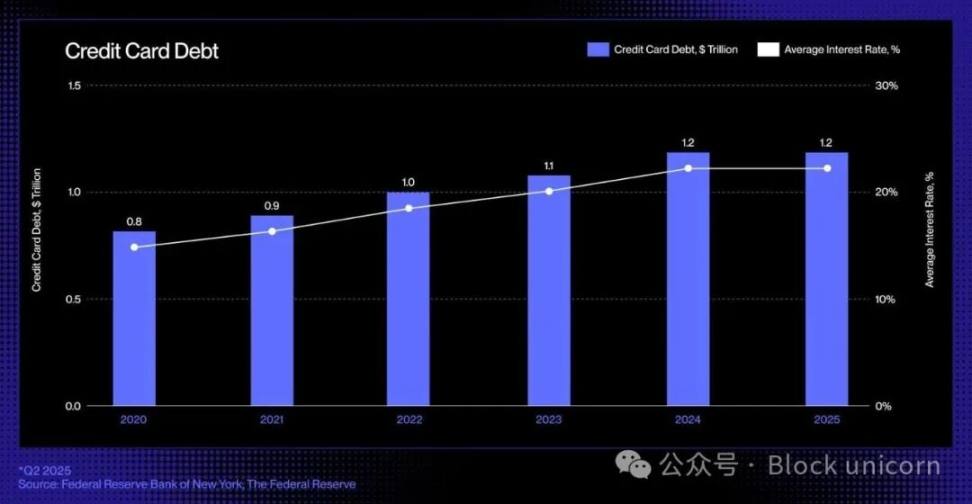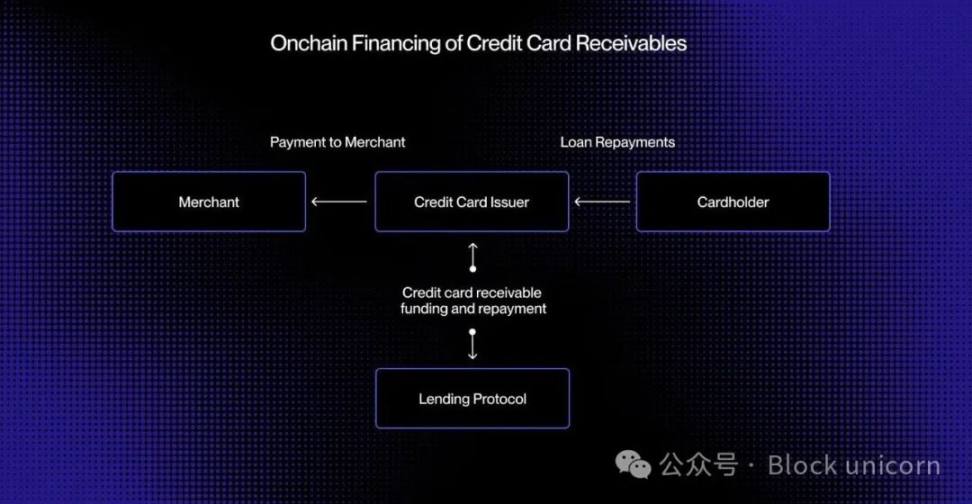Author: haonan
Translator: Block unicorn
Introduction
Users in the global unsecured consumer credit market are like the fat sheep of modern finance—slow to act, lacking judgment, and lacking mathematical ability.
As unsecured consumer credit shifts towards the stablecoin track, its operational mechanisms will change, and new participants will have the opportunity to share in the profits.
Huge Market
In the United States, the primary form of unsecured lending is credit cards: this ubiquitous, highly liquid, and instantly available credit tool allows consumers to borrow without providing collateral while shopping. Credit card debt continues to grow, currently reaching approximately $1.21 trillion.

Outdated Technology
The last major transformation in the credit card lending sector occurred in the 1990s when Capital One introduced a risk-based pricing model, a groundbreaking initiative that reshaped the landscape of consumer credit. Since then, despite the emergence of new banks and fintech companies, the structure of the credit card industry has remained largely unchanged.
However, the emergence of stablecoins and on-chain credit protocols has brought new foundations to the industry: programmable money, transparent markets, and real-time funding. They are expected to ultimately break this cycle and redefine the generation, financing, and repayment of credit in a digital, borderless economic environment.
In today's card payment systems, there is a time lag between authorization (transaction approval) and settlement (the card issuer transferring funds to the merchant through the card network). By moving the funds processing to the blockchain, these receivables can be tokenized and financed in real-time.
Imagine a consumer purchasing goods worth $5,000. The transaction is immediately authorized. Before settling with Visa or Mastercard, the issuer tokenizes the receivable on-chain and receives $5,000 worth of USDC from a decentralized credit pool. Once the settlement is complete, the issuer sends these funds to the merchant.
Later, when the borrower repays, the repayment amount is automatically returned to the on-chain lender through a smart contract. Similarly, the entire process occurs in real-time.
This approach enables real-time liquidity, transparent funding sources, and automatic repayments, thereby reducing counterparty risk and eliminating many of the manual processes that still exist in today's consumer credit.

From Securitization to Funding Pools
For decades, the consumer credit market has relied on deposits and securitization to achieve large-scale lending. Banks and credit card issuers bundle thousands of receivables into asset-backed securities (ABS) and then sell them to institutional investors. This structure provides ample liquidity but also brings complexity and opacity.
"Buy Now, Pay Later" (BNPL) lenders like Affirm and Afterpay have demonstrated the evolution of the credit approval process. They no longer offer universal credit limits but instead review each transaction at the point of sale, treating a $10,000 sofa differently from a $200 pair of sneakers.
This transaction-level risk control produces standardized, divisible receivables, each with a clear borrower, term, and risk profile, making them ideal for real-time matching through on-chain lending pools.
On-chain lending can further expand this concept by creating dedicated credit pools customized around specific borrower demographics or purchase categories. For example, one credit pool could fund small transactions for prime borrowers, while another could specifically cater to subprime consumers for travel installments.
Over time, these funding pools may evolve into targeted credit markets, achieving dynamic pricing and providing transparent performance metrics for all participants.
This programmability opens the door to more efficient capital allocation, better rates for consumers, and the establishment of an open, transparent, and instantly auditable global unsecured consumer credit market.

Emerging On-Chain Credit Stack
Reimagining unsecured loans for the on-chain era is not merely about transplanting credit products onto the blockchain; it requires fundamentally rebuilding the entire credit infrastructure. In addition to issuers and processing institutions, the traditional lending ecosystem relies on a complex network of intermediaries:
We need new credit scoring methods. Traditional credit scoring systems, such as FICO and VantageScore, may be transplantable to the blockchain, but decentralized identity and reputation systems could play a more significant role.
Lending institutions will also need credibility assessments, equivalent to ratings from S&P, Moody's, or Fitch, to evaluate underwriting quality and repayment performance.
Finally, those less glamorous but crucial aspects of loan collection also need improvement. Debt denominated in stablecoins still requires enforcement mechanisms and recovery processes, combining on-chain automation with off-chain legal frameworks.
Stablecoin cards have bridged the gap between fiat currency and on-chain consumption. Lending protocols and tokenized money market funds redefine savings and returns. Bringing unsecured credit on-chain perfects this triangular relationship, enabling consumers to borrow seamlessly, while investors can transparently fund credit, all driven by open financial infrastructure.
免责声明:本文章仅代表作者个人观点,不代表本平台的立场和观点。本文章仅供信息分享,不构成对任何人的任何投资建议。用户与作者之间的任何争议,与本平台无关。如网页中刊载的文章或图片涉及侵权,请提供相关的权利证明和身份证明发送邮件到support@aicoin.com,本平台相关工作人员将会进行核查。




